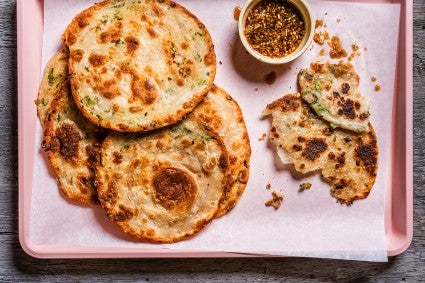


In Taiwan, where I live, the flatbreads are both versatile and resilient. They can be folded into countless flaky layers, flavored with scallions and lard, then shaped to hold all sorts of fillings — from eggs and sausage to oozing cheddar cheese. Crispy on the outside, yet soft and tender within, these flatbreads are a textural delight.
The secret? Boiling water.
Combining scalding hot liquid with flour is an age-old bread baking trick. Although this technique is most widely recognized in East Asian baking, it is universal, from French pain bouilli (porridge bread) to Scandinavian scalded rye bread.
And it is particularly key to soft, stretchy flatbreads in countless forms: In Mexico, it’s used to make flexible flour tortillas, while in India, it’s what makes roti so pliable. Here's why.

When hot water is mixed with flour, the heat partially denatures the flour's proteins and reduces gluten formation. Gluten is the protein in dough that gives it its structure and elasticity. (You can see it in action during the windowpane test, where you stretch a piece of dough until it becomes thin and translucent without tearing.) For some breads you need that strong gluten formation — it's what gives the dough strength, which in turn supports a good rise. But in flatbreads, that gluten can be a hindrance. The hot water effectively weakens that stretch — gluten will still form, but dough won’t have that same rubber band-like bounce; this, in turn, results in a softer, more pliable dough.

A hot water dough is easier to manipulate because it doesn’t have the same elasticity as doughs where you need a robust gluten development, so it can be stretched more easily. Scallion pancakes, a recipe from King Arthur's forthcoming Big Book of Bread, and shou zhua bing (Chinese flatbreads) both benefit from this technique: The hot water dough can be stretched and layered many times while shaping without becoming tough or unworkable. Some steamed dumpling recipes use a hot water dough to achieve papery thin wrappers, and it’s also how potsticker skins can be rolled paper-thin yet crisp up beautifully in the pan. (Conversely, doughs made without hot water have a stiffer consistency and are tougher to roll out.)
Beyond just affecting gluten formation, adding boiling water to a dough makes it more moist. The hot water pre-gelatinizes the flour’s starches so they can absorb more liquid; the retained moisture prevents the bread from becoming dry or crumbly and promotes a softer texture, making it especially great for flexible breads that need to be folded, like tortillas and soft wrap bread. (This method can also be used for flatbreads that don’t use wheat flour, like in corn tortillas. The hot water helps bind the dough better and makes it less likely to crack.)

It’s also an excellent preservation technique. If you’ve ever left bread out and noticed it going stale, that’s due to a process called starch retrogradation. As bread cools, starches crystallize, drawing moisture out and causing the bread to become dry. Because a hot water dough locks in more moisture, these flatbreads stay fresh longer, and as a result, using hot water dough is a great way to extend their shelf life.
In a large bowl, gradually pour the boiling water into the flour, stirring as you add it with the handle-end of a wooden spoon or chopsticks. Don’t pour in all the water at once, as this can lead to uneven hydration or clumping. The flour and hot water mixed together will form a shaggy mass. Then, transfer the dough to a lightly floured surface and knead until smooth.
Don’t be afraid to experiment; the hot water dough technique is versatile in creating softer and longer-lasting baked goods. So, the next time you make flatbread, consider reaching for the kettle.
Find more smart techniques and well-tested recipes in The Big Book of Bread, available for pre-order now and launching on October 22!
Cover photo by Rick Holbrook; food styling by Kaitlin Wayne.

